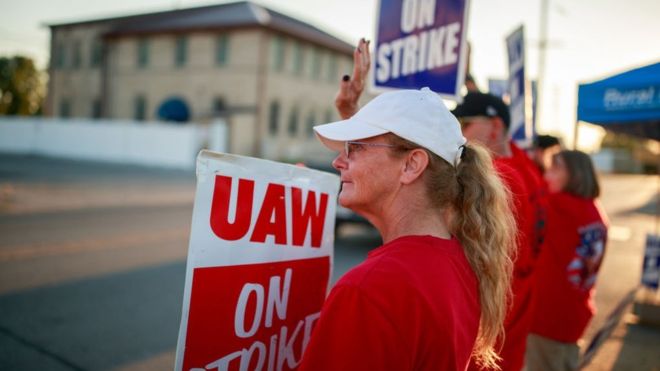
Workers with picket signs mark every entrance to the General Motors plant in Flint, Michigan. With them is all the paraphernalia of a long stay – tables piled with snacks and water bottles, wood and steel bins to make fires during the night, and dozens of signs bearing the slogan “UAW on strike”.
It’s the same picture at the Hamtramck plant just an hour’s drive away, and there are similar scenes at GM facilities across the US.
Nearly 49,000 workers walked out on strike on 16 September.
“We’re prepared to be out here as long as takes,” says Bill Brewer, a quality control inspector at the Flint plant.
Mr Brewer has worked at GM for 42 years. This is his third strike. It’s the longest one he’s been on.
Each day the strike costs General Motors an estimated $90m (£72.3m).
Workers are also losing money. The United Auto Workers union (UAW) has been providing $250 a week to each striking worker to help them get by, but many have had to dip into their savings.
Stephanie Pink, a 31-year-old mother who has worked at GM’s Hamtramck plant for four years, said the union warned her to save in the weeks leading up to the strike.
“It’s really hard, even with my savings,” she says, “But we’ve got to fight for what’s right.”
The plant she works in is scheduled to shut in January 2020.
The heart of the union’s argument is that employees made concessions during the financial crisis to keep GM from shutting down.
In 2009, GM filed for bankruptcy. Piles of debt and slowing car sales amid a global recession led the company to the brink of collapse. The US government stepped in to keep the company and industry alive. It gave GM roughly $40bn in loans in exchange for a 61% stake in the company.
Workers agreed to pay caps, a two-tier pay scale and allowed GM to hire temporary workers who wouldn’t have job security or benefits.
Since the bailout, GM has rebuilt itself and earned billions of dollars in profits. Employees say they are owed a bigger part of that.
“We put in just as much work in these plants and putting these cars together as anybody else with a suit on or a dress on or with heels,” says Anesha Powell, an engine line worker who has been with GM for nearly four years.
As part of the 2009 deal, the UAW agreed to cap wages at $28 an hour. This has since increased to $30, but had those salaries kept pace with inflation workers would be earning $33.77 an hour, the union says.
In 2018, GM’s chief executive officer Mary Barra earned just under $22m.
Companies working with GM are also making sacrifices as the strike wears on.
Moe Thalji, co-owner of Phoenix Transit & Logistics, says his business has lost $1.3m in gross revenue since the walk-out began.
His logistics business transports GM parts between facilities and the carmaker accounts for 90% of his company’s work. With the plants idle, Mr Thalji’s trucks are too. His lot is filled with dozens of trailers packed with GM parts.
So far he has had to cut more than 100 workers.
“I don’t sleep at night,” Mr Thalji says. “There are families that I am supporting with my company. We’ve been dipping into our savings and we probably have another three to four weeks before we are completely empty.”
The reverberations of the strike are being felt across the state of Michigan where GM has its headquarters. So far the state has lost an estimated $13.8m in gross tax revenue, according to Anderson Economic Group.
The auto industry is Michigan’s biggest employer. As well as the big three US carmakers – GM, Ford and Chrysler – it also has related businesses such as parts suppliers and transportation firms like Phoenix Transit & Logistics.
Manufacturing makes up 19% of Michigan’s economy. The state was experiencing a manufacturing slowdown before the strike began, and there are growing fears that a recession could be triggered if GM workers remain on the picket line much longer.
The UAW is asking for higher wages, assurances that GM will assign new products to US plants that are scheduled to be idled, and changes to a profit-sharing agreement.
But uncertainty about the wider US economy and car industry are also stalling talks.
GM has been investing millions in new technology, including electrification, with no clear sign of when those vehicles will become profitable. Workers are concerned electric cars, which take fewer workers to build, will mean job cuts.
Hanging over all of it is the threat of a broader economic downturn in the US economy.
“We’re looking at the next four years being very uncertain,” says Kristin Dziczek, vice president for the Center for Automotive Research.
She says trade worries and changing consumer habits mean GM might not be able to make some of the concessions the union is after.
For workers that may not be good enough.
Outside the Hamtramck plant, Torrance Willison – who’s worked at GM for 34 years – says: “We had to do a lot of sacrificing. General Motors is on stronger ground because of it. And now we are just hoping to reap some of the benefits.”
